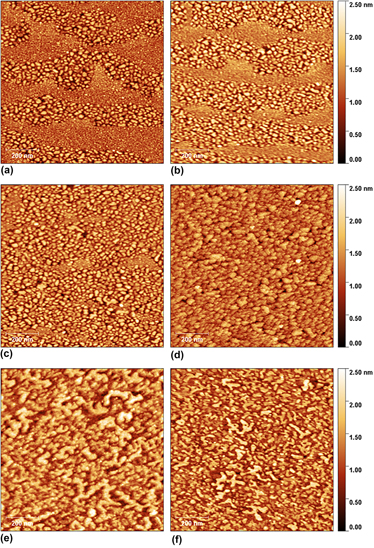 $\sqrt 3 \times \sqrt 3$ surfaces
$\sqrt 3 \times \sqrt 3$ surfacesPublished online by Cambridge University Press: 21 August 2017

The nucleation and growth of Al on 7 × 7 and  $\sqrt 3 \times \sqrt 3$R30 Al reconstructed Si(111) that result in strain-free Al overgrown films grown with an atomically abrupt metamorphic interface are compared. The reconstructed surfaces and abrupt strain relaxations are verified using reflection high-energy electron diffraction. The topography of evolution is examined with atomic force microscopy. The growth of Al on both the surfaces exhibits 3D island growth, but the island evolution of growth is dramatically different. On the 7 × 7 surface, mounds formed are uniformly distributed across the substrate, and growth appears to proceed uniformly. Alternatively, on the
$\sqrt 3 \times \sqrt 3$R30 Al reconstructed Si(111) that result in strain-free Al overgrown films grown with an atomically abrupt metamorphic interface are compared. The reconstructed surfaces and abrupt strain relaxations are verified using reflection high-energy electron diffraction. The topography of evolution is examined with atomic force microscopy. The growth of Al on both the surfaces exhibits 3D island growth, but the island evolution of growth is dramatically different. On the 7 × 7 surface, mounds formed are uniformly distributed across the substrate, and growth appears to proceed uniformly. Alternatively, on the  $\sqrt 3 \times \sqrt 3$R30 surface, Al atoms exhibit a clear preference to form mounds near the step edges. During Al growth, mounds increase in size and number, expanding out from step edges until they cover the whole substrate. Consistent expression of a mounded nucleation and growth mode imparts a physical limitation to the achievable surface roughness that may impact the ultimate performance of layered devices such as Josephson junctions that are critical components of superconducting quantum circuits.
$\sqrt 3 \times \sqrt 3$R30 surface, Al atoms exhibit a clear preference to form mounds near the step edges. During Al growth, mounds increase in size and number, expanding out from step edges until they cover the whole substrate. Consistent expression of a mounded nucleation and growth mode imparts a physical limitation to the achievable surface roughness that may impact the ultimate performance of layered devices such as Josephson junctions that are critical components of superconducting quantum circuits.
Contributing Editor: Artur Braun